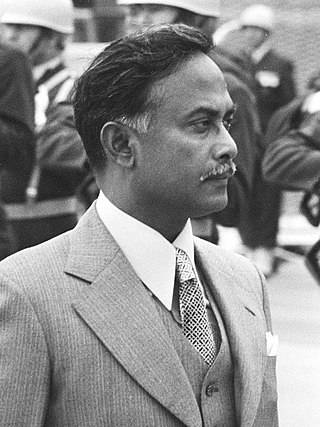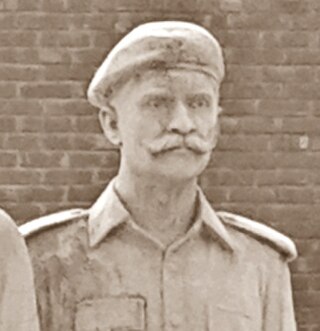Related Research Articles

Ziaur Rahman was a Bangladeshi military officer and dictator who served as the President of Bangladesh from 1977 until his assassination. He was the founder of the Bangladesh Nationalist Party (BNP) and served as its chairman until his assassination. He previously served as the second chief of army staff from 1975 to 1978 with a minor break.

The East Bengal Regiment is an infantry regiment and the largest military formation of the Bangladesh Army.
Abu Taher was a Bengali military serviceman, who served in the Pakistan Army, and later in BDF. He crossed into India around early August and reported to the Indian authorities. After a week screening at Dehradun, India, Taher reported to Kolkata, Bangladesh Provincial government at 8 Theatre Rd. He was ordered to report to Sector 11 of Mukti Bahini under command of Major Ziaur Rahman, he became the sector commander after him. He served in BDF from end of August to 2 November 1971. He was awarded the medal Bir Uttom for his gallantry in the liberation war. He was released from military service by Indian military medical board in Pune, India after his leg was amputated. After independence, he was inducted into the Bangladesh Army for administrative retirement with legacy rank of lieutenant colonel. After settling in with family, the government of Bangladesh appointed him with employment at Kumilla. Later Taher turned into a political activist and leader of the left-wing Jatiyo Samajtantrik Dal.

Muhammad Ataul Gani Osmani, was a Bengali military leader. Osmani's career spanned five decades, beginning with service in the British Indian Army in 1939. He fought in the Burma Campaign during World War II. After the partition of India in 1947, he joined the Pakistan Army and served in the East Bengal Regiment, retiring as a colonel in 1967. Osmani joined the Provisional Government of Bangladesh in 1971 as the commander-in-chief of the nascent Bangladesh Forces. Regarded as the founder of the Bangladesh Armed Forces, Osmani retired as a four-star general from the Bangladesh Army in 1972.
Khaled Mosharraf, Bir Uttom was a Bangladeshi army officer who is known for his role in the Bangladesh Liberation War and the subsequent coups in post-independence Bangladesh. After deposing Khondakar Mustaq Ahmad in the 3 November 1975 coup, Mosharraf was assassinated on 7 November 1975.

Armed Forces Day is observed in Bangladesh on 21 November. This signifies the day in 1971, when the members of the Bangladesh army, navy and air force were officially united and launched joint operations against the Pakistan occupation forces. On 16 December 1971, the Pakistani Army of 93,000 surrendered to the allied forces of Bangladesh Forces and Indian Army, ending the Liberation War of Bangladesh.
Muhammed Abul ManzurBU was a Bangladeshi military officer who commanded the Bangladesh Forces operations in Sector 8 during the Bangladesh Liberation War against Pakistan in 1971. He was allegedly involved in the assassination of the then-President of Bangladesh, Ziaur Rahman. The erstwhile Chief of Army Staff and alleged mastermind of Rahman's assassination, Hussein Muhammad Ershad, had put a standing shoot-to-kill order on Manzur's life—he was killed shortly after being captured at the border. About a year later, Ershad initiated a bloodless coup d'état and took over the Central Government, holding power until 1990.
Shafaat Jamil, Bir Bikrom was a Bangladesh Army colonel. He was the commanding officer of the 3rd East Bengal Regiment of Z Force Brigade in Sector 11 of Bangladesh Forces during the War of Bangladesh Independence in 1971. He was among the first Bengali officers who rebelled against the Pakistani Army in the 1971 Liberation War of Bangladesh and later fought in 11 sector and in Sylhet sector.
Kazi Mohammed Shafiullah Bir Uttam, also known as K. M. Shafiullah, is a retired Bangladeshi general, former Chief of Army Staff of the Bangladesh Army, and former Member of Parliament.

1st East Bengal Regiment or 1st Bengal also known by its nickname The Senior Tigers of Bangladesh Army.
The Indian Army had no standby force ready in 1971 with the specific task of attacking East Pakistan, one of the many reasons why India did not immediately intervene after Pakistan launched Operation Searchlight in March 1971. Indian Army's Eastern Command was tasked with defending the northern and eastern borders and fighting the insurgencies in Nagaland, Mizoram and Naxalites in West Bengal at that time.
The Battle of Kamalpur, launched against the Pakistan Army, is one of the most significant battles fought by Bangladesh Forces in 1971 during its war of independence from Pakistan. The Pakistan Army set up a military camp at Kamalpur which was attacked by 1st East Bengal Regiment of Z Force several times. The first attack was made on June 12, and a second attack was made on July 31, 1971. Finally, on December 4, Pakistan Army had to withdraw and fell back to their headquarters at Jamalpur after an attack by the Bangladesh Forces and Indian Army. In the aftermath of the battle, Pakistani troops were defeated and Jamalpur became free.

Salauddin Mumtaz was a military officer who fought for the Bangladeshi side in the 1971 Bangladeshi War of Independence.
Bir Bikrom Hafizuddin Ahmed is a Bangladesh Nationalist Party politician, a retired Bangladesh Army major, and a 6-term Jatiya Sangsad member representing the Bhola-3 constituency. He fought in the Bangladesh Liberation War and was awarded the third highest gallantry award in Bangladesh, the Bir Bikrom, for his courage. He is also a retired footballer and one of the few from East Pakistan to have reprsented the Pakistan national football team.
K Force was a military brigade of Bangladesh Forces in 1971 headed by Major Khaled Mosharraf as per the direction of the Provisional Government of Bangladesh in exile. The brigade was a part of regular army under the Bangladesh Armed Forces formed with the 4th, 9th and 10th Battalion of East Bengal Regiment.
S Force was a military brigade of the Bangladesh Armed Forces that was formed under the leadership of Major K M Shafiullah on October 1, 1971. The brigade was composed of the 2nd and 11th East Bengal Regiments.
Martyr Lt. Anwar Hossain was a Bangladesh Army officer who fought in the Bangladesh Liberation war. He was killed in the war and posthumously awarded Bir Uttom, the second highest gallantry award in Bangladesh.
Mohsin Uddin Ahmed was a Brigadier General of the Bangladesh Army and recipient of Bir Bikrom, the third highest gallantry award of Bangladesh, for his actions during the Bangladesh Liberation War. He was the senior most official of Bangladesh Army executed for the assassination of Ziaur Rahman.
Mohammad Ziauddin, BU is a retired Bangladeshi military officer, who was the Commanding Officer of the 1st East Bengal Regiment during the Bangladesh Liberation War. He was awarded the Bir Uttom, the country's second highest gallantry award for his outstanding bravery in the Liberation War. His certificate number was 22.
References
- ↑ "War Calendar: Chronology of events taking place during 1971". The Daily Star. Freedom in the air. 26 March 2014. Retrieved 15 January 2015.
- 1 2 3 4 মুক্তিযুদ্ধের পূর্বাপর : কথোপকথন-এ কে খন্দকার (in Bengali). Rokomari.Com. 17 April 2012. Retrieved 19 May 2013.
- ↑ Document for showing The Bangladesh Gazette announcing the promotion of Ziaur Rahman to Lieutenant General in the book Bangladesh: A Legacy of Blood by Anthony Mascarenhas
- 1 2 3 এক জেনারেলের নীরব সাক্ষ্য স্বাধীনতার প্রথম দশক (১৯৭১-১৯৮১)-মে. জে. মইনুল হোসেন চৌধুরী (অব.) (in Bengali). Rokomari.Com. 1 March 2013. Retrieved 19 May 2013.
- ↑ Mahmud-Ur-Rashid (23 March 2008). "Sectors & Armed Forces of the Liberation War 1971". Star Campus. The Daily Star. Retrieved 15 December 2016.
- ↑ "Sectors & Armed Forces of the Liberation War 1971", The Daily Star, 23 March 2008, retrieved 15 January 2015
- 1 2 3 4 5 রক্তেভেজা একাত্তর-মেজর (অব.) হাফিজ উদ্দিন আহমেদ বীর বিক্রম (in Bengali). Rokomari.Com. Retrieved 19 May 2013.
- 1 2 "The Battle of Kamalpur-31 July 1971". The Daily Star. 15 December 2007. Archived from the original on 3 October 2019.
- ↑ Sukhwant, Singh (1980). India's Wars Since Independence: Liberation of Bangladesh, Vol. 1. Lancer Publisher LLC. ISBN 978-1-935501-60-2.
- ↑ Sukhwant, Singh (1980). India's Wars Since Independence The Liberation Of Bangladesh, Vol 1. Lancer Publisher LLC. ISBN 9781935501602.
- ↑ Major Rafiqul Islam PSC, এগারোটি সেক্টরের বিজয় কাহিনী (Egaroti Sectorer Bijoy Kahini); SBN-978-984-8939-27-7, Shorobritto Prokashon, October-2011, pg-117
- ↑ Colonel Shafaat Jamil (1998). একাত্তরের মুক্তিযুদ্ধ, রক্তাক্ত মধ্য আগষ্ট ও ষড়যন্ত্রময় নভেম্বর (in Bengali). Sahitya prakasa.
